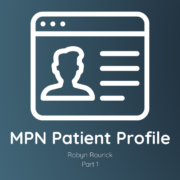How Does Inhibitor Therapy Work to Treat Myelofibrosis?
How Does Inhibitor Therapy Work to Treat Myelofibrosis? from Patient Empowerment Network on Vimeo.
What is inhibitor therapy? Dr. Joseph Scandura reviews approved JAK inhibitor therapies and explains how they work to treat myelofibrosis.
Dr. Joseph Scandura is Associate Professor of Medicine and Scientific Director of the Silver MPN Center at Weill Cornell Medicine. Learn more about Dr. Scandura, here.
Related Programs

Which Gene Mutations Impact Myelofibrosis Treatment Options? |

What Are the Considerations When Choosing Myelofibrosis Therapy? |

What’s YOUR Role in Making Myelofibrosis Treatment Decisions? |
Transcript
Katherine Banwell:
How does inhibitor therapy work to treat myelofibrosis?
Dr. Scandura:
So, the therapies that we have now that are approved therapies that are in this class are ruxolitinib (Jakafi) and fedratinib (Inrebic).
Both of these agents act to block signaling through a protein called JAK2. You can think of JAK2 as being part of the antennae system that a cell uses to communicate with the rest of the body. And so, our blood-forming cells have a lot of input from the body saying, “Okay, we need some of these kinds of cells, we need some of those kinds of cells,” and it’s a very adaptive system. And JAK2 is involved in a lot of the signaling in this as part of the antennae system.
And what happens in the myeloproliferative neoplasms is that signaling is a bit excessive.
And so, it’s like the volume is turned up too loud and the signaling is causing the cells to do things, make too many cells, make the wrong kinds of cells, and JAK2 is part of that signaling system. So, these inhibitors kind of help turn down the volume of the signaling in these blood-forming cells. They are drugs that have good activity in improving symptoms, they have great success in reducing the size of the spleen, they can be useful for a few years to many years. They are not curative therapies. We don’t think of them as therapies that change the course of disease, but they certainly have an important role in helping people feel better. There are other inhibitor therapies that are in clinical development.
So, clinical trials of some of these drugs have really impressive activity, but none is approved yet by the FDA.
I hope and expect we’ll have a couple more drugs available in the coming years. And there’s a lot of excitement in clinical trials in terms of some of the activities that are being seen, and really quite tolerable therapies, so not a lot of side effects for patients. And so, I think it’s kind of an exciting time for physicians and for patients and a lot more options now and, I think, a lot more options coming down the line.










